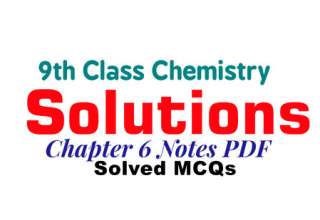In this post, I am sharing 1st Year Chemistry Chapter 10 Important MCQs PDF Notes for the students of FSC Part 1. Name of this Chapter is Electrochemistry. Students can download Electrochemistry Chapter Solved MCQs in PDF format from here. This file contains only 05 pages. These Chemistry Notes are for all the boards working under Punjab Board like Gujranwala Board, Lahore Board, Faisalabad Board, Multan Board, Rawalpindi Board, Sargodha Board, DG Kahn Board, and Sahiwal Board. Here are complete 1st Year Chemistry Notes.
11th Class Chemistry Chapter 10 “Electrochemistry” Important MCQ’s PDF Download
The oxidation number of chromium in K2Cr2O7 is;
a) 14
b) 12
c) 6
d) none of these
When fused PbBr2 is electrolyzed when:
a) bromine appears at cathode
b) lead is deposited at the cathode
c) lead appears at the anode
d) none of these happens
An electrochemical cell is based upon:
a) acid base reaction
b) redox reaction
c)nuclear reaction
d) none of the above
During the redox reaction, an oxidizing agent:
a) gains electrons
b) is oxidized
c) losses electrons
d) is hydrated
In an oxidation process the oxidation number of the element:
a) Increases
b) decreases
c) does not change
d) none of these
Electric current passes through both molten and solution form of NaCl because of
a) ionic bonding
b) Na+ and Cl ions
c) ions of water
d) hydration of ions
The process in which electric current is used to carry our a non-spontaneous redox reaction is called
a) electrolyte
b) electrolysis
c) metallic conductor
d) none of these
The process in which ionic compound when fused ou dissolved in water split up into charged particles is called
a) electrolysis
b) hydration
c) ionization
d) conduction
The metallic conductor in contact with the solution are called
a) insulator
b) electrodes
c) electrolyte
d) Down cell
caustic soda is obtained by electrolysis of conc. Aqueous solution of NaCl in a cell called;
a) Daniell’s cell
b) Nelson’s cell
c) Down’s cell
d) voltalic cell
Stronge reducing agents have
a) Greater positive value of standard reduction potential.
b) Greater negative value of standard reduction potential.
c) lesser positive value of standard reduction potential.
d) none of these
greater the value of standard reduction potential of a species indicates
a) greater its tendency to accepted electrons
b) lesser tendency to accept electrons
c) greater tendency to loose electrons
d) none of these
Relevant Notes
- FSC 1st Year Chemistry Chapter 1 Additional MCQs PDF
- FSC 1st Year Chemistry Chapter 2 Additional MCQs PDF
- 11th Chemistry Chapter 3 Additional MCQs PDF
- FSC Part 1 Chemistry Chapter 4 Additional MCQs PDF
- FSC Part 1 Chemistry Chapter 5 Additional MCQs PDF
- 1st Year Chemistry Chapter 6 Additional MCQs PDF
- FSC 1st Year Chemistry Chapter 8 Additional MCQs
- FSC 1st Year Chemistry Chapter 9 Additional MCQs PDF





